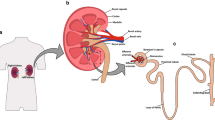Abstract
Purpose. The purpose of this study was to assess whether LLC-PK1 renal epithelial cells could serve as an in vitro model for studying the renal tubular reabsorption of protein drugs.
Methods. The association of 111In-labeled model protein drugs, bovine serum albumin (BSA), superoxide dismutase (SOD), soybean trypsin inhibitor (STI), and [Asu1,7]-eel calcitonin (Asu-ECT), with the monolayers of LLC-PK1 renal epithelial cells was characterized under various conditions.
Results. The cellular association of these proteins was temperature-dependent and varied according to the protein. Saturation kinetics were observed for STI association, with the apparent Km and Vmax values determined to be 66.3 µg/ml and 250 ng/mg protein/min, respectively. The association of STI decreased with increases in medium pH from 5.4 to 8.4 and was inhibited significantly by 2,4-dinitrophenol, sodium azide, cytochalasin B, and colchicine, suggesting that the cellular association involved endocytosis. Mutual inhibition was observed in competitive binding experiments with the four protein drugs, suggesting that they shared a common binding site on the luminal membrane of LLC-PK1 cells. Taken together, these findings show that a variety of protein drugs bind to LLC-PK1 cells in a non-specific manner and possibly undergo endocytosis, a phenomenon that is similar to in vivo proximal tubular reabsorption.
Conclusions. LLC-PK1 renal epithelial cells would be a suitable model system for the study of the renal proximal tubular reabsorption of protein drugs.
Similar content being viewed by others
REFERENCES
D.A. Wall and T. Maack. Endocytic uptake, transport, and catabolism of proteins by epithelial cells. Am. J. Physiol. 248: C12–C20 (1985).
F.A. Carone, D.R. Peterson, S. Oparil, and T.N. Pullman. Renal tubular transport and catabolism of proteins and peptides. Kidney Int. 16: 271–278 (1979).
K. Mihara, T. Hojo, M. Fujikawa, Y. Takakura, H. Sezaki, and M. Hashida. Disposition characteristics of protein drugs in the perfused rat kidney. Pharm. Res. 10: 823–827 (1993).
Y. Takakura, K. Mihara, and M. Hashida. Control of the disposition profiles of proteins in the kidney via chemical modification. J. Controlled Release 28: 111–119 (1994).
K. Mihara, Y. Oka, K. Sawai, Y. Takakura, and M. Hashida. Improvement of therapeutic effect of human recombinant superoxide dismutase on ischemic acute renal failure in the rat via cationization and conjugation with polyethylene glycol. J. Drug Targeting 2: 317–321 (1994).
G.J.A. Gstraunthaler. Epithelial cells in tissue culture. Renal. Physiol. Biochem. 11: 1–42 (1988).
J.R. Duncan and M.J. Welch. Intracellular metabolism of indium-111-DTPA-labeled receptor targeted proteins. J. Nucl. Med. 34: 1728–1738 (1993).
J.S. Schwegler, B. Heppelmann, S. Mildenberger, and S. Silbernagl. Receptor-mediated endocytosis of albumin in cultured opossum kidney cells: A model for proximal tubular protein reabsorption. Pflügers Arch. 418: 383–392 (1991).
S.A. Kempson, A.L. Ying, J.A. McAteer, and H. Murer. Endocytosis and Na+/solute cotransport in renal epithelial cells. J. Biol. Chem. 264: 18451–18456 (1989).
M. Takano, Y. Ohishi, M. Okuda, M. Yasuhara, and R. Hori. Transport of gentamicin and fluid-phase endocytosis markers in the LLC-PK1 kidney epithelial cell line. J. Pharmacol. Exp. Ther. 261: 669–674 (1994).
A. Bernard, A.O. Amor, C. Viau, and R. Lauwerys. The renal uptake of proteins: A nonselective process in conscious rats. Kidney Int. 34: 175–185 (1988).
E.I. Christensen, H.G. Rennke, and F.A. Carone. Renal tubular uptake of protein: Effect of molecular charge. Am. J. Physiol. 244: F436–F441 (1983).
A. Wohlwend, K. Malmström, H. Henke, H. Murer, J.D. Vassalli, and J.A. Fisher. Calcitonin and calcitonin gene-related peptide interact with the same receptor in cultured LLC-PK1 kidney cells. Biochem. Biophys. Res. Commun. 131: 537–542 (1985).
E.I. Christensen, and T. Bjerke. Renal tubular uptake of protein: Effect of pH. Renal Physiol. 9: 160–166 (1986).
A. Kowluru, R.A. Kowluru, S. Solomon, and L. Marttinez. Protein glycation: Effects upon protein recognition by the proximal tubule. Life Sci. 50: 281–286 (1992).
Rights and permissions
About this article
Cite this article
Takakura, Y., Morita, T., Fujikawa, M. et al. Characterization of LLC-PK1 Kidney Epithelial Cells as an in Vitro Model for Studying Renal Tubular Reabsorption of Protein Drugs. Pharm Res 12, 1968–1972 (1995). https://doi.org/10.1023/A:1016256325921
Issue Date:
DOI: https://doi.org/10.1023/A:1016256325921




